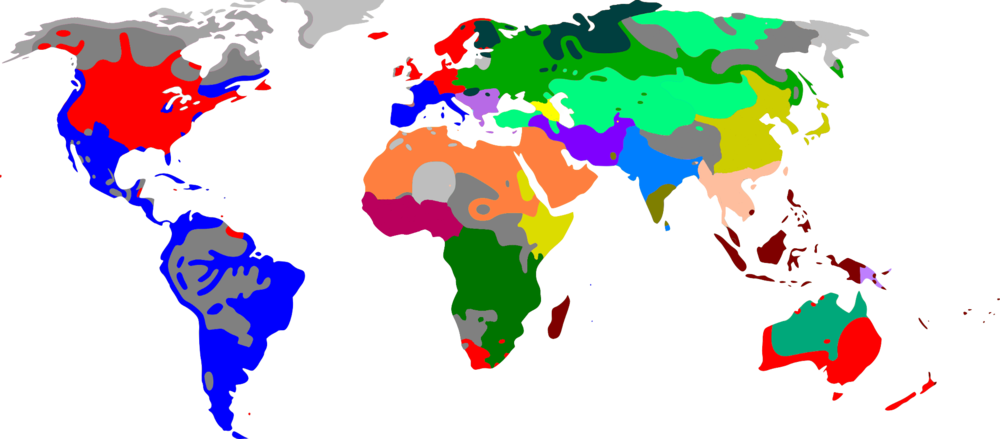Universal Languages
In the future, regional unity and pride will be seen as desirable, in order not to lose indigenous cultures and languages. Esperanto is a fine idea, but it scrubs through many of the important differences of regions and cultures. A slightly finer grain of distinction yields approximately 15 world languages, as seen below. Within each zone, the Universal Language is taught and mandatory, but no one group or culture claims it as there own. Each Universal Language is a kind of abstraction, an easy to learn language for everyone in the zone, but an artificial creation unlike natural languages. It is a kind of neutral meeting ground, a no-man's land. Nevertheless, for outsiders, learning a Universal Language is a gateway into grammar and vocabulary for each zone.
While implementation will take time, there can be several phases to helping promote region cooperation and esprit de corps. 1) the language is taught in school electively. Concordantly, "World English" and other attempts to make individual, natural languages which belong to a particular people group become the lingua franca of any region must stop. 2) Ph.D's and scientific journals must be written in a Universal Language. Parallel versions in the regional language and the Universal Language are published side by side. 3) Public education and progressively public signage are written in the Universal Language. Nothing local or indigenous is ever replaced, but anything with international reach or goals must be communicated in a Universal Language. 4) Finally, the unique writing system of each region (where it isn't already being deployed) is introduced, replacing the reign of Latin or other writing systems.
| Name | Region | Pop. | Description |
|---|---|---|---|
| Dan'a'yo | Sinosphere | 1500 | Take the phonology of Old Korean, a writing-system of Japanese, and the syntax of Middle Chinese, and you've got a simplified, logical language equally comprehensible to all the relevant parties. |
| Neo-Sanskrit | Hindi Belt | 1400 | Harkening back to the good 'ol day, we have created language understandable to any Indo-Aryan speaker. It will be written in a script from which hundreds are descended today. |
| Intralingua | Latinsphere | 800 | Fully utilizing the Latin alphabet, Interlingua is an immediately understandable to Romance language speakers, and English speakers find it even easier than Spanish. |
| Folksprak | Germania | 500 | By returning English to its Germanic roots, the U.S.A.'s hidden divisions become clear and a new era of communication becomes possible, across Northern Europe, and the world. |
| Kintu | Bantusphere | 450 | The eastern region of Africa is dominated by Swahili at present, but it is not a neutral language. An auxiliary language was created for Pan-African purposes. |
| Indo-Malaysian | East Indies | 380 | The region already has a great deal of mutual intelligibility; all that is needed is a regulation and standardization of vocabulary and a neutral grammar to be setup. |
| Guosa | West Africa | 340 | Benin, Burkina Faso, Gambia, Ghana, Guinea-Bissau, Guinea, Ivory Coast, Liberia, Mali, Mauritania, Nigeria, Niger, Senegal, Sierra Leone,Togo. |
| Interslavic | Slavisphere | 300 | There have long been attempts to unify the Slavic people under one language, as they once were under Old Church Slavonic. Southern Slavic languages are grouped separately (see "Balkan" below). |
| Middle Semitic | [Semitisphere | 290 | The Arabics and Israeli are all designed languages, so why not design a compromise? The Syriac script is also a middle ground, and a helpful linguistic blend to incorporate. |
| MSEAL | SE Asia | 233 | The areal effects of this region are generally recognized, but it will take a great deal of research into the hundreds of barely-documented languages in the region. Perhaps a "Pan-MSEA" movement will arise in the future ... |
| Dravindian | South India | 230 | Despite having been in proximity with the Indo-Aryan languages for 2,000 year, these languages still maintain a separate identity and require their own regional language, often going back to Proto-Dravidian for words and grammar. |
| Zens | Greater Persia | 175 | The Iranian languages will be extremely difficult to unite, given that some are Nominative-Accusative, and some are (Split) Ergative. This will not be easy. The vocabulary and phonology will be very nice, though. |
| Jalpi | Pan-Turkey | 170 | The Turkic people have had a desire to unite for over a century and a half. |
| SEDES | Horn of Africa | 117 | Ethiopia and Eritrea form a long-recognized sprachbund, stretching to include Somalia and Djibouti. Around 90 languages already have much in common. |
| Balkan | w:Balkans | 60 | Through a long history of living together, an indisputable sprachbund exists in the area. Greek letters make a neutral writing system. |
| Samboka | Samoyed | 26 | These languages have split enormously and have very complicated grammars. |
| Caucas | Caucasia | 23 | Maybe not a sprachbund, but needs unifying |
Really unlikely candidates are the Native American languages, the Qinghai sprachbund, the Celtic languages, and others. Papua New Guinea seems to have naturally created a creole to meet this exact kind of problem, in the form of Tok Pisin
